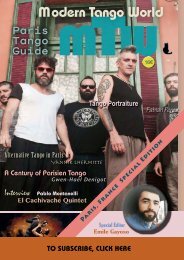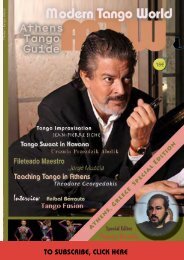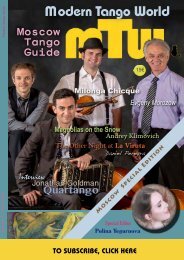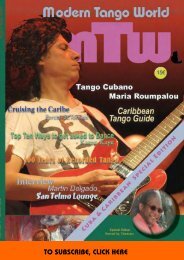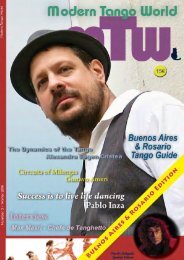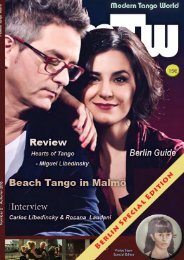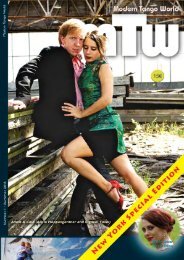Modern Tango World #4 (Bucharest, Romania)
Romania Special Features Romania’s Modern Tango Scene Dragos Samoil 3 An Act of Beauty Laura Iaru 6 Guitar Man Alexandru Eugen Cristea 12 Guide to Tango in Romania 16 The Ladies of Guardia Viejo Renato Mantioni 20 Interview with Miguel di Genova Marco Buso 24 Tango Addiction Kiran Bajaj Sawhney 28 New Tango Music Arndt Büssing 32 The Obamas Tango in Buenos Aires 38 DJ/VJ-ing - Victroleras, Tandas & Cortinas Igor Shpigelman 40 Tango Moves - Abrazos Raymond Lauzzana 44 Letters to the Editor 47
Romania Special Features
Romania’s Modern Tango Scene Dragos Samoil 3
An Act of Beauty Laura Iaru 6
Guitar Man Alexandru Eugen Cristea 12
Guide to Tango in Romania 16
The Ladies of Guardia Viejo Renato Mantioni 20
Interview with Miguel di Genova Marco Buso 24
Tango Addiction Kiran Bajaj Sawhney 28
New Tango Music Arndt Büssing 32
The Obamas Tango in Buenos Aires 38
DJ/VJ-ing - Victroleras, Tandas & Cortinas Igor Shpigelman 40
Tango Moves - Abrazos Raymond Lauzzana 44
Letters to the Editor 47
Create successful ePaper yourself
Turn your PDF publications into a flip-book with our unique Google optimized e-Paper software.
At first, tango dancers were reluctant to dance.<br />
They regarded him as a good guitar player, but it<br />
too difficult to dance to, almost impossible. Tudor<br />
used to play a European tango with a Spanish influence.<br />
But because he was always in search of new<br />
things, he picked up new songs and adapted his way<br />
of playing.<br />
Tudor received several original Argentine tango<br />
songs and their scores, from the tango school. This<br />
permitted him to take a fascinating musical trip from<br />
the Spanish influenced European tangos to the<br />
originalcArgentine tango music. His adaptation of<br />
Malena dates from these first encounters with the<br />
dance world. Since then, all of the tango songs that<br />
he plays are adaptations from the original music.<br />
The manner in which kr adapts the original tango<br />
music to play it on a single guitar is quite unique.<br />
Not all the songs can be adapted in this way. It depends<br />
on the range of the melody, the tempo, the<br />
general feeling of the music. When he has listened<br />
to the song long enough to learn it by heart, he is<br />
able to hum it from beginning to end. After determining<br />
the key in which to play, the fun begins, preserving<br />
rhythm and melody so that people are able<br />
to recognize the song, and also comfortably dance.<br />
The original form and structure of the song is clearly<br />
helps people to predict the outcome of the song,<br />
and dance on the musical phrases, using elements<br />
such as doble tiempo, sincopa, corte, etc. This process<br />
may be quite laborious, but the result is amazing.<br />
An illusion is created that there is more than<br />
one person playing a perfect tango — a song for<br />
listening, dancing and improvisation.<br />
The pleasure of playing for someone yo be able to<br />
dance is quite a feat for a musician. Because of his<br />
innovative guitar playing method, he quickly gained<br />
the trust of dancers and he began to play extensively<br />
for tango schools. He remembers the first milonga in<br />
<strong>Bucharest</strong> where he played live tango music. It was a<br />
happy and fun event, with people who were always<br />
touching the floor while stepping and thus producing<br />
that unique sound which at first seemed quite odd.<br />
In time and a lot of patience and some explanations<br />
from the dance teachers. they got into his music. After<br />
the first milonga, came the second, and the third,<br />
and then his name got in the hearts of every Argentine<br />
tango dancer in <strong>Bucharest</strong>. And so it happened<br />
that other musicians become interested in Argentine<br />
tango music. He joined with double bass player<br />
Ciprian Parghel and his late mother, Anca Parghel,<br />
a fascinating singer. After a few concerts with them,<br />
he co-founded the first tango orchestra in <strong>Romania</strong><br />
with Constantin Stanciu, Mihai Melinescu and<br />
Ciprian Parghel in 2004.<br />
Between 2009 and 2010 he was based in Strasbourg<br />
where his wife is pursuing a PhD. He came in contact<br />
some of the tango schools there, and proposed<br />
thay he play in their milongas. One of the teachers<br />
invited him for an audition. She was very impressed<br />
by the special manner in which Tudor was playing.<br />
He later played with success at the local milongas.<br />
For this first milonga, he needed to add some new<br />
songs to his repertoire, in order to be able to play<br />
for a three to four hours milonga. He played a variety<br />
other types of music, like Latin American music,<br />
jazz standards, etc..All were highly appreciated by<br />
the <strong>Tango</strong> Nuevo enthusiasts.<br />
— 15 —




